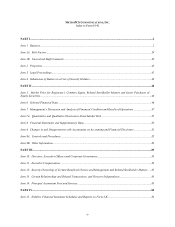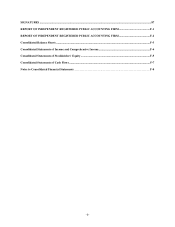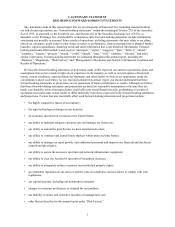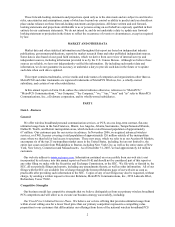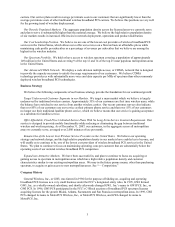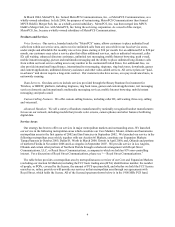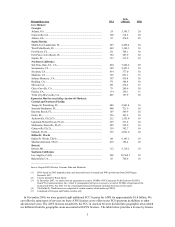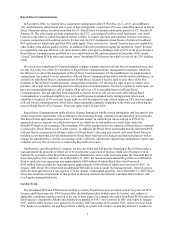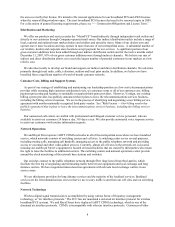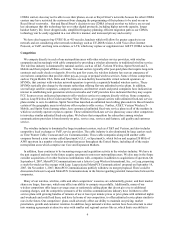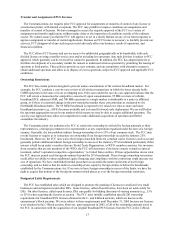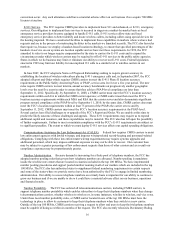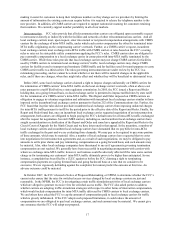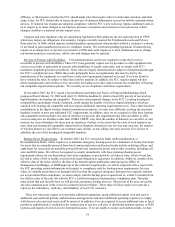Metro PCS 2007 Annual Report Download - page 20
Download and view the complete annual report
Please find page 20 of the 2007 Metro PCS annual report below. You can navigate through the pages in the report by either clicking on the pages listed below, or by using the keyword search tool below to find specific information within the annual report.9
CDMA carriers also may not be able to use their phones on our or Royal Street’ s networks because the other CDMA
carriers may have restricted the customers from changing the programming of their phones to be used on our or
Royal Street’ s networks. Our and Royal Street’ s decision to use CDMA is based on what we believe are several
key advantages that this technology has over other digital protocols, including higher network capacity, longer
handset battery life, fewer dropped calls, simplified frequency planning, efficient migration path as our CDMA
technology can be easily upgraded in a cost effective manner, and increased privacy and security.
We have also begun to buy EVRC-B, or 4G vocoder, handsets which will allow for greater capacity in our
network and are considering other network technology such as EV-DO Revision A with Voice-Over-Internet
Protocol, or VoIP, and long term evolution, or LTE, which may replace or supplement our 1xRTT CDMA network.
Competition
We compete directly in each of our metropolitan areas with other wireless service providers, with wireline
companies and increasingly with cable companies by providing a wireless alternative to traditional wireline service.
The wireless industry is dominated by national carriers, such as AT&T, Verizon Wireless, Sprint Nextel and T-
Mobile and their prepaid affiliates or brands. National carriers typically offer post-paid plans that require long-term
contracts and credit checks or deposits. Over the past few years, the wireless industry has seen an emergence of
several new competitors that provide either pay-as-you-go or prepaid wireless services. Some of these competitors,
such as Virgin Mobile USA, Helio and Tracfone, are non-facility based mobile virtual network operators, or
MVNOs, that contract with wireless network operators to provide a separately branded wireless service. These
MVNOs typically also charge by the minute rather than offering flat-rate unlimited service plans. In addition,
several large satellite companies, computer companies, and Internet search and portal companies have indicated an
interest in establishing next generation wireless networks and VoIP providers have indicated that they may acquire
FCC licenses or use unlicensed spectrum to offer wireless services to compete directly with us. Some companies,
such as Leap Wireless d/b/a Cricket and Sure West Wireless, are regional carriers with unlimited fixed-rate service
plans similar to ours. In addition, Sprint Nextel has launched an unlimited local calling plan under its Boost brand in
certain of the geographic areas in which we offer or plan to offer service. Further, AT&T, Verizon Wireless,T-
Mobile, and Sprint Nextel among others, have announced unlimited fixed-rate service plans in all of the markets in
which we currently operate or plan to operate. These unlimited fixed-rate service plans may cause other competitors
to introduce similar unlimited fixed-rate plans. We believe that competition for subscribers among wireless
communications providers is based mostly on price, service area, services and features, call quality and customer
service.
The wireline industry is dominated by large incumbent carriers, such as AT&T and Verizon, and also includes
competitive local exchange or VoIP, service providers. The cable industry is also dominated by large carriers such
as Time Warner Cable, Comcast and Cox Communications. These cable companies along with another cable
company formed a joint venture called SpectrumCo LLC, or SpectrumCo, which bid on and acquired 20 MHz of
AWS spectrum in a number of major metropolitan areas throughout the United States, including all of the major
metropolitan areas which comprise our Core and Expansion Markets.
In addition, there continues to be increasing merger and acquisition activity in the wireless industry. We have in
the past acquired and may in the future acquire spectrum to enter new metropolitan areas. We also may in the future
consider acquisitions of or other business combinations with, companies in addition to acquisitions of spectrum. On
September 4, 2007, MetroPCS Communications sent a letter to Leap Wireless International, Inc., or Leap, proposing
a stock-for-stock tax-free merger with Leap. Leap rejected MetroPCS Communications’ proposal on September 16,
2007. On November 1, 2007, MetroPCS Communications publicly withdrew its merger proposal. There could be
discussions between Leap and MetroPCS Communications in the future regarding potential transactions between the
companies.
Many of our wireless, wireline, cable and other competitors’ resources are substantially greater, and their market
shares are larger, than ours, which may affect our ability to compete successfully. Additionally, many of our
wireless competitors offer larger coverage areas or nationwide calling plans that do not give rise to additional
roaming charges, and the competitive pressures of the wireless communications industry have led them to offer
service plans with growing bundles of minutes of use at lower per minute prices or price plans with unlimited nights
and weekends and could lead them, and have led some of our competitors, to offer unlimited service plans similar to
ours in the future. Our competitors’ plans could adversely affect our ability to maintain our pricing, market
penetration, growth and customer retention. In addition, large national wireless carriers have been reluctant to enter
into roaming agreements at attractive rates with smaller and regional carriers like us, which limits our ability to


